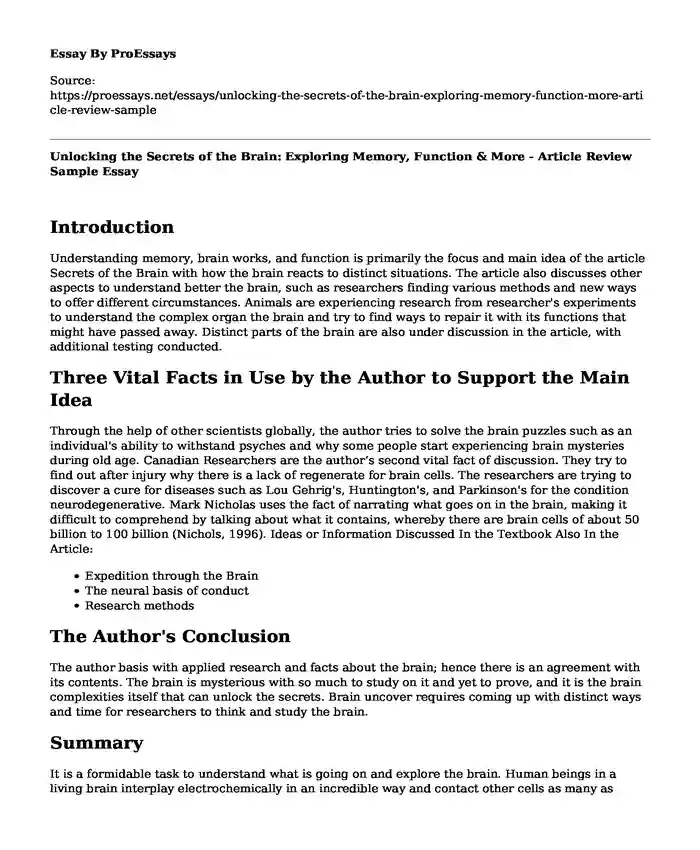Introduction
Understanding memory, brain works, and function is primarily the focus and main idea of the article Secrets of the Brain with how the brain reacts to distinct situations. The article also discusses other aspects to understand better the brain, such as researchers finding various methods and new ways to offer different circumstances. Animals are experiencing research from researcher's experiments to understand the complex organ the brain and try to find ways to repair it with its functions that might have passed away. Distinct parts of the brain are also under discussion in the article, with additional testing conducted.
Three Vital Facts in Use by the Author to Support the Main Idea
Through the help of other scientists globally, the author tries to solve the brain puzzles such as an individual's ability to withstand psyches and why some people start experiencing brain mysteries during old age. Canadian Researchers are the author‘s second vital fact of discussion. They try to find out after injury why there is a lack of regenerate for brain cells. The researchers are trying to discover a cure for diseases such as Lou Gehrig's, Huntington's, and Parkinson's for the condition neurodegenerative. Mark Nicholas uses the fact of narrating what goes on in the brain, making it difficult to comprehend by talking about what it contains, whereby there are brain cells of about 50 billion to 100 billion (Nichols, 1996). Ideas or Information Discussed In the Textbook Also In the Article:
- Expedition through the Brain
- The neural basis of conduct
- Research methods
The Author's Conclusion
The author basis with applied research and facts about the brain; hence there is an agreement with its contents. The brain is mysterious with so much to study on it and yet to prove, and it is the brain complexities itself that can unlock the secrets. Brain uncover requires coming up with distinct ways and time for researchers to think and study the brain.
Summary
It is a formidable task to understand what is going on and explore the brain. Human beings in a living brain interplay electrochemically in an incredible way and contact other cells as many as 10,000 as researchers begin to comprehend (Nichols, 1996). There is emerging of thought and human consciousness with brain neural activity. Scientists with devotion try to discover between brain cells the trigger and flow of neurons with electric impulses. Across the synapse, chemicals discharge among the brain cells, giving contact to millions of brain cells mobilizing them and giving rise to mental activity. Researchers progressively link particular roles for specific brain regions with synapses, for instance, to anticipate weighs and events consequences of conduct within the frontal lobes. Motivation, mood, and memory association are through the nearby amygdala, the hippocampus.
Conclusion
According to Phillips, in the article, the brain executes planning functions through the frontal lobes that assist the nucleus accumbens in making a final decision (Nichols, 1996). Wiring of the brain is relevant but changes circuits with a lasting change, such as anxiety because of an event. Anxious personalities from people afflict anger, anxiety, and depression, leading to stress disorder conditions. Different memory functions handling is through the brain, and it possible to see using PET scans. The functions are through wide distribution, but their concentrations occur in one hemisphere. Regeneration of brain cells is a challenge for scientists to damage cells. However, in the future, a form of treatment through unlocking brain secrets may assist in the regeneration of human neurons. Scientists need to understand the brain's secrets to intervene from occurring in the brain potential trauma shocks with ways to avert permanent alterations. The human brain is complicated and extraordinary, and many brain understandings and ideas are yet to be proved, thus requiring unlocking thorough knowledge of its mysteries.
References
Duffy, K. G. (1998). Psychology 98-99 (28th ed). Retrieved from
https://www.amazon.com/Psychology-98-99-28th-ed/dp/0697391957
Nichols, M. (1996). Secrets of the BRAIN: Maclean’s JANUARY 22, 1996. Retrieved from https://archive.macleans.ca/article/1996/1/22/secrets-of-the-brain.
Cite this page
Unlocking the Secrets of the Brain: Exploring Memory, Function & More - Article Review Sample. (2023, Nov 16). Retrieved from https://proessays.net/essays/unlocking-the-secrets-of-the-brain-exploring-memory-function-more-article-review-sample
If you are the original author of this essay and no longer wish to have it published on the ProEssays website, please click below to request its removal:
- Paper Sample: The Importance of Sulfur Nitrogen Heterocyclic in Chemistry and Pharmacology
- Paper Example on Mathematical Modeling Techniques
- Durban South Africa Paper Example
- NASA and Fossil Records - Essay Sample
- Water as a Reactant Paper Example
- Unearthing the Untold: Paper Example on Archaeology in the Philippines
- Free Essay Example on Glacier Bivachny: A Flowing Glacier in Central Pamir







